10 things we never knew about (Sony) lenses
If you want to target professionals, you can't just build cameras – you also have to provide a pro-quality lens range too
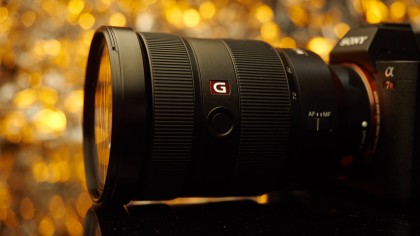
What we saw and why
Sony flew journalists from across Europe to its Amsterdam HQ to see and try its new G Master lenses. It was a chance for Sony engineers to explain what they were trying to achieve with these new designs, and for journalists to try them out, get some pictures and get some technical insights straight from the people who made them.
These lenses are made for Sony's mirrorless cameras – mainly the full-frame a7-series models, though they will also work on APS-C mirrorless cameras like the brand new a6300.
The A7 II, A7R II and A7S II have been attracting growing interest from professional stills photographers and, especially, pro videographers. And while in the amateur market it's new cameras that grab all the headlines, the bigger question for pros is whether the system offers the lenses they need.
The new G Master lenses are the answer. They include a new 24-70mm f/2.8 standard zoom, a 70-200mm f/2.8 telephoto zoom and an 85mm f/1.4 portrait lens – three must-have lens types for any pro system.
So we got to spend a day finding out why Sony made these lenses, how they're different and what they're like to use.

1 Can any lens be sharp at f/1.4?
Just so that we all knew how sharp Sony's new 84mm f/1.4 portrait lens was, the company fixed up a series of studio photo shoots. Normally, you'd expect a fast prime lens to deliver slightly soft detail at its maximum aperture, but the Sony 85mm f/1.4 GM was a revelation, with high contrast and super-crisp definition, even when opened right up at f/1.4.
In fact the biggest problem was the extremely shallow depth of field. First, we were shooting on full frame Sony A7R cameras, and larger sensors bring shallower depth of field right from the start. Second, the 85mm focal length is pretty long – depth of field diminishes with longer focal lengths. Third, f/1.4 is a very wide aperture. In fact it's two stops faster than a pro f/2.8 zoom lens like the new 24-70mm f/2.8 G Master.
This means you have to be absolutely precise with your focusing. It's not just a case of whether you focus on the near eye or far eye (always choose the near eye in a portrait), but whether you've focused on the eyelashes or the eye itself. Worse, if either you or the subject moves even a little between the time the focus locks on and the shutter trips, the focus will drift out.
In fact, it's best to leave the camera in continuous shooting mode so that you can pick through the images later to find those focused at the perfect point.
This isn't a fault with the Sony 85mm f/1.4, it's an indication of its incredible resolution even at its maximum aperture – any focus error is clearly visible.

Here's one of our portrait shots taken at the 85mm lens's f/1.4 maximum aperture. You can click here to see the full size version.

Or just take a look at this – we've blown up the area around our subject's eye so that you can see the level of detail captured.
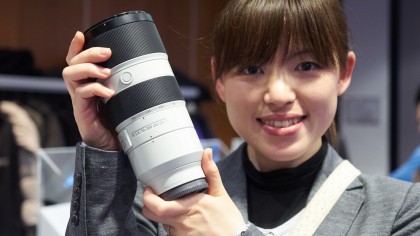
2 Sony's 70-200mm f/2.8 OSS
The only examples of the new 70-200mm f/2.8 Sony had on display were this pre-production version – which we weren't allowed to shoot with – and one that had been sawn in half for display.
This is an extremely important lens for Sony. The 70-200mm f/2.8 telephoto zoom has become of one of the three essential lenses in any professional system. It can be used for anything from relatively close-range sports photography to portraits and events.
The constant f/2.8 maximum aperture means there's no need to rethink the available lens apertures in manual mode just because you're changing the zoom setting, and you can use faster shutter shutter speeds in low light. This lens does have its own internal optical stabilization (OSS) mechanism, but that can only counter camera movement – if your subject itself is moving, then a faster shutter speed is the only thing that can freeze it.
This is a complex lens but, interestingly, it's not a whole lot bigger than Sony's existing 70-200mm f/4 lens. It's just one of the three lenses displayed by Sony at its Amsterdam headquarters, and all three will be very important as Sony tries to gain traction in the pro photography market with its full frame A7 series cameras.

3 Sony 70-200mm f/2.8 cutaway
Here's what the new Sony 70-200mm f/2.8 GM looks like when it's sawn in half (no, we don't know where the other half is). This gives you an idea of the sophistication and engineering complexity of modern zoom lenses, especially those designed for the demanding professional market.
This lens has no fewer than 23 elements in 18 groups. An 'element' is a single glass lens mounted on its own, while a 'group' is two or more lens elements cemented together as a single object.
In this lens, these elements include one of Sony's brand new high-precision XA elements "sharpness and clarity throughout zoom range". There are also two aspherical elements – these have a complex, non-spherical profile to help counter complex aberrations and are tricky to make – plus four ED and two super-ED elements. ED stands for 'extra low dispersion' – a more exotic and expensive glass material typically used to reduce or eliminate chromatic aberration.

4 Sony 24-70mm f/2.8 GM cutaway
Here's another cutaway, and this time it's the brand new Sony 24-70mm G Master lens. Interestingly, Sony already has a Zeiss-branded 24-70mm f/2.8 lens in its full-frame E-mount lens range, but a presentation by Sony executives indicated that the Zeiss and G Master lenses are parallel brands designed for slightly different needs.
The G Master version seen here has 18 elements in 13 groups, and includes a Sony XA lens element, two aspherical lens elements and one ED/super-ED element. Unlike the 70-200mm lens, this one does not include optical stabilization – later Sony A7 series cameras have stabilization built into the body, however.
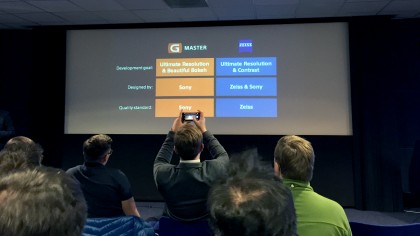
5 Zeiss versus Sony - what's going on?
Sony already works with premium lens manufacturer Zeiss on optics for its professional camera range, so where do the new G Master lenses fit in?
Sony explained – sort of – with this feature comparison matrix. It seems both lens ranges are designed to produce ultimate resolution, but where Zeiss lenses are engineered to deliver maximum contrast too, Sony's engineers are aiming for beautiful bokeh – this is the visual quality of out-of-focus backgrounds, and the way that defocused highlights are rendered.
Bokeh is a big deal for many photographers, but a quality that can be pretty hard to define, especially with lab test data.

What does great bokeh look like? Sony demonstrated some sample images on giant screens, and they did look rather good.

6 G Master range explained
Sony's boast with the G Master lenses is that it's delivered "tomorrow's lenses today". It's one of the world's biggest sensor makers and so it reckons it knows what's coming, and that its G Master lenses must be designed for "future quality". Already, Sony says, 4K video has become the norm and 8K is the next big leap.
At the heart of the G Master system is Sony's new XA lens technology. It's found a way of manufacturing aspherical lens elements with a higher degree of precision than ever before of just 0.01 microns.
If you can imagine something one thousandth of a millimetre across, well then it's a hundred times smaller than that.
Each of Sony's new G Master lenses boasts one of these XA lens elements within its optical design, and this is to boost the two properties at the heart of the G Master philosophy: high resolution and beautiful bokeh.

Sony had one of its new XA lens elements on display in an illuminated cabinet. Not sure what we thought we were going to see here.
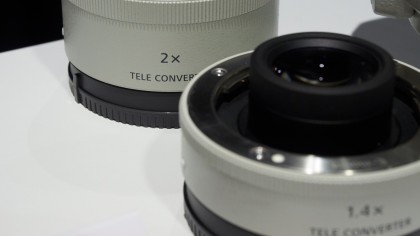
7 Zoom further
Sony also announced two new teleconverters which fit between the lens and the camera body to increase the lens's focal length. The downside is that this comes at the cost of reduced maximum aperture, but if you're using Sony's new 70-200mm f/2.8 G Master lens, you have got some to spare.
The teleconverters come in two strengths. The 1.4x converter increases the focal length 1.4x while reducing the maximum aperture by 1 stop, so the 70-200mm f/2.8 lens would become a 98-280mm f/4. The 2x converter doubles the lens's focal length while reducing the maximum aperture by 2 stops, so the 70-200mm f/2.8 would become a 140-400mm f/5.6
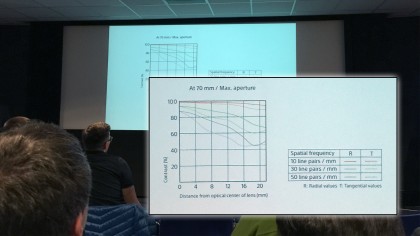
8 MTF at 50 line pairs per millimetre
MTF, or Modulation Transfer Function, is what optical engineers talk about when they're in the pub. It's a technical measure of lens resolution that can be used to assess a lens's performance and make comparisons between lenses. In plain English, it measures how effectively a lens can capture detail at different resolutions.
Normally, lenses are tested at at two resolutions, say 10 line pairs per millimetre and 30 line pairs per millimetre. The amount of contrast they capture at those resolutions is measured on a chart – the closer they get to a value of 1 (100%) the better.
But with the G Master lenses, Sony engineers have gone a step further to test their optics at an unprecedented 50 line pairs per millimetre. In other words they're testing their lenses at resolutions so fine that no-one usually tries.
We carry out our own lens resolution tests on techradar, but all this talk of MTF charts shows how serious Sony is about making its pro cameras and lenses a force to be reckoned with.
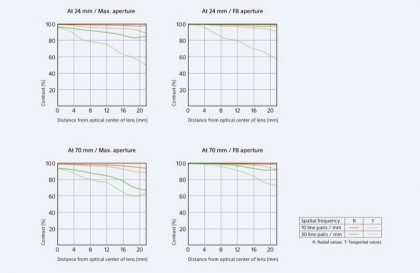
Sony's website only publishes MTF charts for 10 and 30 line pairs per millimetre, but we got to see the 50 lppm charts too.
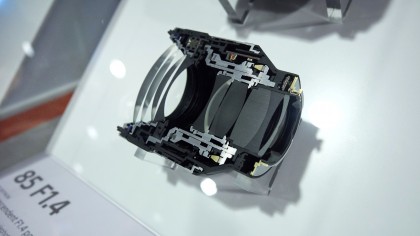
9 Why are lenses so heavy?
(And why do they cost so much?)
Here's a picture of the new Sony 85mm f/1.8 G Master lens cut in half down the middle. You can see from this that the rear half of the lens nearest the camera body is practically solid glass. And then there's the huge size of the front elements – this is in proportion to the focal length of the lens and its maximum aperture, and an 85mm f/1.4 lens is always going to have BIG glass at the front.

Close-ups of the cutaway model are just as revealing. This lens has 11 elements in 8 groups, and they're not just crammed into a metal tube any old how. They're held in precise alignment by complex cams, shims, clamps and spigots (probably). If you look closely, you might be able to make out the edge of the circular ring-drive SSM autofocus motor and its ball-bearing construction – this is needed to provide both the power needed to drive these big lens elements and the required speed and smoothness too – you can see it better in this diagram (below) from the Sony website.
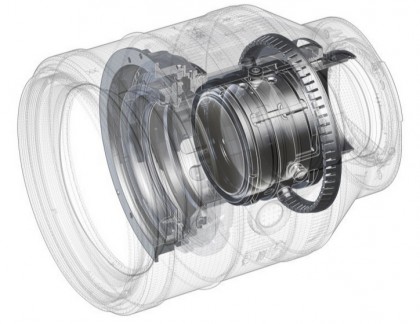
Incidentally, the even-more-complicated 70-200mm f/2.8 G Master lens has a ring-drive motor for the front focusing group and a dual linear actuator for a rear focusing group too. The engineers have to find ways of shifting these massive lumps of glass with the precision of a Swiss watch.
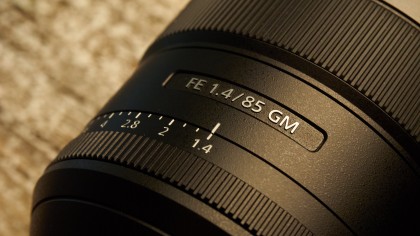
10 Aperture rings are making a comeback
Old-school photographers always bemoan the fact that on modern cameras the lens aperture is controlled from the camera body via dials and menus, but there are signs that aperture rings on lenses could be on their way back. Fuji uses them extensively on its X-mount lenses, for example, to recreate the traditional camera handling qualities that have made its X-series cameras so successful.
And here is an aperture ring on the new Sony 85mm f/1.4, though in fairness this is probably aimed more at videographers than stills shooters – video types like to be able to change the iris (aperture) setting quickly and easily with a ring on the lens.
They also like iris adjustments to be smooth, not 'clicky', which is why there's a switch on the lens barrel to turn the clicking on or off. That way, stills photographers can keep their clicks.
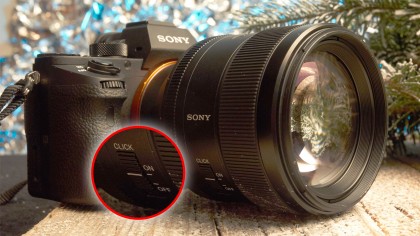

Rod is an independent photographer and photography journalist with more than 30 years' experience. He's previously worked as Head of Testing for Future’s photography magazines, including Digital Camera, N-Photo, PhotoPlus, Professional Photography, Photography Week and Practical Photoshop, and as Reviews Editor on Digital Camera World.